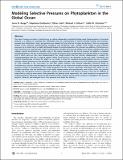| dc.contributor.author | Chisholm, Sallie (Penny) | |
| dc.contributor.author | Jahn, Oliver | |
| dc.contributor.author | Dutkiewicz, Stephanie | |
| dc.contributor.author | Bragg, Jason G. | |
| dc.contributor.author | Follows, Michael J | |
| dc.date.accessioned | 2010-05-14T18:07:20Z | |
| dc.date.available | 2010-05-14T18:07:20Z | |
| dc.date.issued | 2010-03 | |
| dc.date.submitted | 2010-02 | |
| dc.identifier.issn | 1932-6203 | |
| dc.identifier.uri | http://hdl.handle.net/1721.1/54793 | |
| dc.description.abstract | Our view of marine microbes is transforming, as culture-independent methods facilitate rapid characterization of microbial diversity. It is difficult to assimilate this information into our understanding of marine microbe ecology and evolution, because their distributions, traits, and genomes are shaped by forces that are complex and dynamic. Here we incorporate diverse forces—physical, biogeochemical, ecological, and mutational—into a global ocean model to study selective pressures on a simple trait in a widely distributed lineage of picophytoplankton: the nitrogen use abilities of Synechococcus and Prochlorococcus cyanobacteria. Some Prochlorococcus ecotypes have lost the ability to use nitrate, whereas their close relatives, marine Synechococcus, typically retain it. We impose mutations for the loss of nitrogen use abilities in modeled picophytoplankton, and ask: in which parts of the ocean are mutants most disadvantaged by losing the ability to use nitrate, and in which parts are they least disadvantaged? Our model predicts that this selective disadvantage is smallest for picophytoplankton that live in tropical regions where Prochlorococcus are abundant in the real ocean. Conversely, the selective disadvantage of losing the ability to use nitrate is larger for modeled picophytoplankton that live at higher latitudes, where Synechococcus are abundant. In regions where we expect Prochlorococcus and Synechococcus populations to cycle seasonally in the real ocean, we find that model ecotypes with seasonal population dynamics similar to Prochlorococcus are less disadvantaged by losing the ability to use nitrate than model ecotypes with seasonal population dynamics similar to Synechococcus. The model predictions for the selective advantage associated with nitrate use are broadly consistent with the distribution of this ability among marine picocyanobacteria, and at finer scales, can provide insights into interactions between temporally varying ocean processes and selective pressures that may be difficult or impossible to study by other means. More generally, and perhaps more importantly, this study introduces an approach for testing hypotheses about the processes that underlie genetic variation among marine microbes, embedded in the dynamic physical, chemical, and biological forces that generate and shape this diversity. | en |
| dc.description.sponsorship | Center for Microbial Oceanography: Research and Education and Biological Oceanography Programs of the United States National Science Foundation | en |
| dc.description.sponsorship | United States. Dept. of Energy | en |
| dc.description.sponsorship | Gordon and Betty Moore Foudation | en |
| dc.language.iso | en_US | |
| dc.publisher | Public Library of Science | en |
| dc.relation.isversionof | http://dx.doi.org/10.1371/journal.pone.0009569 | en |
| dc.rights | Article is made available in accordance with the publisher's policy and may be subject to US copyright law. Please refer to the publisher's site for terms of use. | en |
| dc.source | PLoS | en |
| dc.title | Modeling Selective Pressures on Phytoplankton in the Global Ocean | en |
| dc.type | Article | en |
| dc.identifier.citation | Bragg JG, Dutkiewicz S, Jahn O, Follows MJ, Chisholm SW (2010) Modeling Selective Pressures on Phytoplankton in the Global Ocean. PLoS ONE 5(3):
e9569. doi:10.1371/journal.pone.0009569 | en |
| dc.contributor.department | Massachusetts Institute of Technology. Department of Biology | en_US |
| dc.contributor.department | Massachusetts Institute of Technology. Department of Civil and Environmental Engineering | en_US |
| dc.contributor.department | Massachusetts Institute of Technology. Department of Earth, Atmospheric, and Planetary Sciences | en_US |
| dc.contributor.approver | Chisholm, Sallie (Penny) | |
| dc.contributor.mitauthor | Chisholm, Sallie (Penny) | |
| dc.contributor.mitauthor | Follows, Michael J. | |
| dc.contributor.mitauthor | Jahn, Oliver | |
| dc.contributor.mitauthor | Dutkiewicz, Stephanie | |
| dc.contributor.mitauthor | Bragg, Jason G. | |
| dc.relation.journal | PLoS ONE | en |
| dc.eprint.version | Final published version | en |
| dc.type.uri | http://purl.org/eprint/type/JournalArticle | en |
| eprint.status | http://purl.org/eprint/status/PeerReviewed | en |
| dspace.orderedauthors | Bragg, Jason G.; Dutkiewicz, Stephanie; Jahn, Oliver; Follows, Michael J.; Chisholm, Sallie W. | en |
| dc.identifier.orcid | https://orcid.org/0000-0002-3102-0341 | |
| mit.license | PUBLISHER_POLICY | en |
| mit.metadata.status | Complete | |
